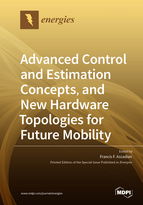Advanced Control and Estimation Concepts, and New Hardware Topologies for Future Mobility
A special issue of Energies (ISSN 1996-1073). This special issue belongs to the section "E: Electric Vehicles".
Deadline for manuscript submissions: closed (30 November 2021) | Viewed by 28276
Special Issue Editor
Interests: autonomous vehicles; alternative powertrain; robust control; energetic modelling; application of artificial intelligence and machine learning
Special Issues, Collections and Topics in MDPI journals
Special Issue Information
Dear Colleagues,
According to the National Research Council, the use of embedded systems throughout society could dominate previous milestones in the information revolution.
Mechatronics is the synergistic combination of electronic, mechanical, controls, software, and systems engineering in the design of processes and products. Mechatronic systems put “intelligence” into physical systems. Embedded sensors/actuators/processors are integral parts of mechatronic systems.
On the one hand, the implementation of mechatronic systems is on the continuous rise, especially in the applications of Future Mobility. On the other hand, manufacturers are working hard to reduce the implementation cost of these systems while trying not to comprise product quality. One way of addressing these conflicting objectives is through automatic controls and virtual sensing.
Therefore, this Special Issue seeks to contribute to advanced control and estimation concepts and new hardware topologies for future mobility. Topics of interest for publication include, but are not limited to:
- New sensor fusion concepts;
- Integrated vehicle dynamics and control architectures (IVDC);
- New energy management and vehicle controls;
- Steer by wire and advanced steering systems and controls;
- New topologies for braking Systems including brake system optimization;
- New traction and anti-lock braking control methods;
- Advanced control methods for vehicle suspensions;
- Low calibration estimation concepts;
- Control and optimization of electric vehicles;
- New alternative powertrains for Future Mobility;
- Application of energy harvesting in Future Mobility;
- New passive and active methods for vehicle dynamics improvement of Future Mobility.
Prof. Dr. Francis F. Assadian
Guest Editor
Manuscript Submission Information
Manuscripts should be submitted online at www.mdpi.com by registering and logging in to this website. Once you are registered, click here to go to the submission form. Manuscripts can be submitted until the deadline. All submissions that pass pre-check are peer-reviewed. Accepted papers will be published continuously in the journal (as soon as accepted) and will be listed together on the special issue website. Research articles, review articles as well as short communications are invited. For planned papers, a title and short abstract (about 100 words) can be sent to the Editorial Office for announcement on this website.
Submitted manuscripts should not have been published previously, nor be under consideration for publication elsewhere (except conference proceedings papers). All manuscripts are thoroughly refereed through a single-blind peer-review process. A guide for authors and other relevant information for submission of manuscripts is available on the Instructions for Authors page. Energies is an international peer-reviewed open access semimonthly journal published by MDPI.
Please visit the Instructions for Authors page before submitting a manuscript. The Article Processing Charge (APC) for publication in this open access journal is 2600 CHF (Swiss Francs). Submitted papers should be well formatted and use good English. Authors may use MDPI's English editing service prior to publication or during author revisions.
Keywords
- estimation
- sensor fusion
- alternative powertrain
- electric vehicles
- vehicle dynamics
- advanced control
- energy harvesting
- steering; suspension
- braking systems
- traction
- ABS






